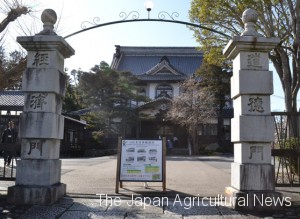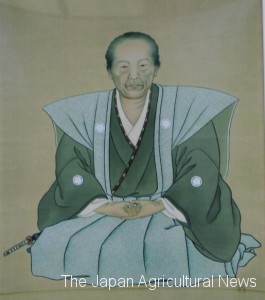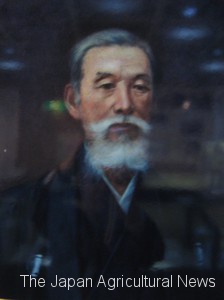Diligence savings, “the road to rescue the village”
The information on activities of Shoshichi Agui (1789 ~ 1863) that, Hotokusha was established in Shimoishida (Shimoishida, Higashi-ku, Hamamatsu city, Shizuoka prefecture) and Shoshichi rescued the poor by interest-free loan, spread throughout the Enshu whole area. Saheiji Okada (1812 ~ 1873) heard the information. Later, Saheiji established “Totominokuni (Tōtōmi Province) Hotokusha” and became president of Dainippon Hotokusha. However, at this point, Saheiji did not know Sontoku and Hotoku thought.
Saheiji invited Shoshichi to his home and received his lecture on Hotoku thought and practice of Shiho program for 3 days in the around-the-clock. Saheiji was convinced that “It’s just the way to save the village,” gathered all the villagers, and let them learn the basics of Hotoku thought for further 4 days.
And in 1848 (Kaei 1), Saheiji established Otohoshi Hotokusha. In addition, he let his son, Ryoichiro ( 1839 ~ 1915 ), go to school of Ninomiya and become personal pupil of Sontoku.
Industry Promotion by establishment of lending office
Then, Ryoichiro became clerk of Hamamatsu prefecture officials. In 1873 (Meiji 6), he was keenly aware of the need for financial institutions to lend money necessary for the industrial revival of the rural and commercial economy, and made proposal against prefecture for the establishment of such institution, and at last he founded the “Shisan kashitsuke-sho (loan office)”. Sakae Koseki, a lecturer and director of Dainippon Hotokusha, investigated situation at that time.
According to Koseki, Saheiji Okada and Ryoichiro Okada made a “motto” in accordance with the teachings of Sontoku. They practiced thorough diligence and savings. Since 1853 (Kaei 6), they donated Kakegawa clan 100 cars as thank-you lump sum and 50 bales of rice as annual donation from surplus they obtained. After the waste clan, this Hotoku-kin (rice) was taken over by the Hamamatsu Prefecture, and total amount was piled up to 20,000 yen. The funds were used to establish the semi-governmental “Shisan kashitsuke-sho.”
In the Meiji Restoration, a major reform was carried out one after another. Impact of the new currency regulations and land tax amendment was great. Currency unit was changed from car to yen, and decimal system of the gold standard was introduced. Land tax was also revised, and common people were so confused to be required payment tax in the new currency.
At the time of establishment of “Shisan Kashitsuke-sho,” one koku (150kg) of rice is equivalent to 2.70 yen or 3 yen. At that time, 20,000 yen is equivalent to 250 million yen.
Ryoichiro Okada became the general manager of the Shisan Kasitsuke-sho, and actively carried out “Emergency reserve, rescue of poor people, reconstruction of poor village” (Article 3, rules of Totominokuni (Tōtōmi Province) Hotokusha), in accordance with the teachings of Hotoku thought.

Main gate of the Dai Nippon Hotokusha is carved “Dotoku mon (Morality Gate)” to the right, and “Keizai mon (Economic Gate)” to the left. (in Kakegawa city, Shizuoka prefecture)
In principle, annual interest rate was set to 5 %, but from time to time, set to 10% or 0%. 60% of revenue was set aside to fund, and remained 40% was used for public charity. In the lending report in 1875 (Meiji 8), we can find the description of “loan of 100 yen to poor villager (non-interest).”
In 1879 (Meiji 12), Ryoichiro aimed to expand of Shisan kashitsuke-sho and began a public offering of Industry Promotion funds. He considered that demand of industrial funds would grow due to iincrease in the size of the civil engineering works and growing demand for industrial capital. Ryoichiro called for investment in volunteers with a new investment and he also invested himself. It was the beginning of the systematic financial business as Shisan kasitsuke-sho. Gathered funds were used for Industry Promotion funds such as Industry Development cost (1900 yen), agriculture research expenses (300 yen), and have contributed to the development of the local industry.
In order to introduce credit cooperatives for industrial development, Meiji government called for the establishment of credit cooperatives to Hotokusha, native organization similar to credit cooperatives. In response to the call, “Kakegawa Shinyokumiai (credit cooperatives)” was born, as the first credit cooperatives of the nation.
【Booklet】Beginning of Cooperatives <Sontoku Ninomiya ④> Now of Hotoku thought (May 30, 2015)



